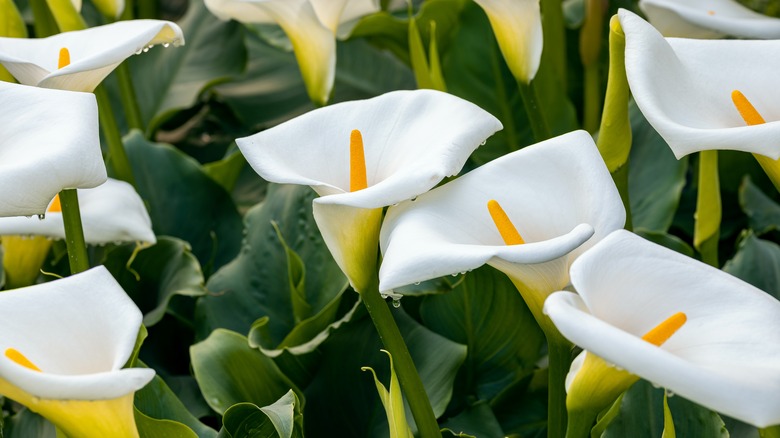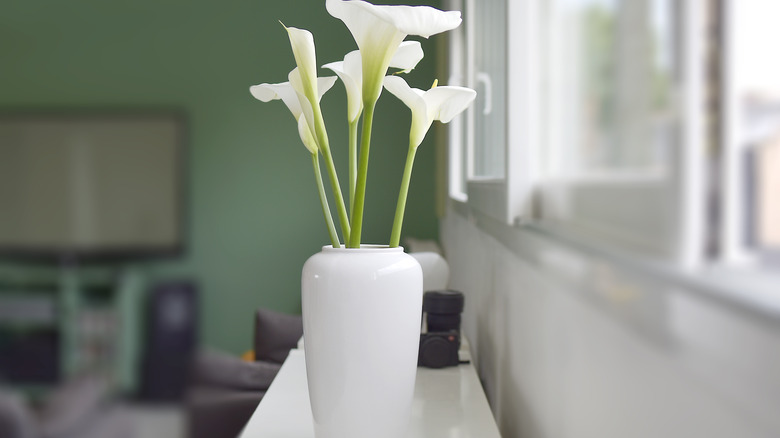How To Keep Calla Lilies Looking Fresh While Blooming This Summer
As Katherine Hepburn insinuated in her iconic dialogue in plays like "Stage Door" and "The Lake," blooming calla lilies (Zantedeschia spp.) have found themselves a place in every occasion from bridal bouquets to funeral arrangements. When cut, they last nearly two weeks, brightening rooms with their innocent white, radiant burgundy, pastel lilac, or rich gold tubular blossoms. When sited in favorable conditions, they greet us for almost a month in flower beds and ornamental gardens. Indeed, they're the bulbs you should be planting in your garden this spring for gorgeous summer interest. Sadly, as calla lilies are wary about ditching the dead weight, or spent flowers after their job is done, they eventually turn drab and dowdy, losing part of their aesthetic appeal. But deadheading can help freshen the lily plants and have them up and 'becoming' pronto.
Contrary to the experience of most other flowering plants, deadheading — the practice of removing faded flowers — doesn't induce a second flush or an encore floral display in calla lilies. That's because all cultivars have a limited set of blooms, albeit extremely long-lasting. Instead, the primary motive for snipping the dead flowers is to keep the bulbous perennials (or annuals, as they're considered up north) neat and visually pleasing; their arrow-like, mottled green foliage carries the show later. The second is to prevent the lilies from wasting their energies in setting seeds and toppling under their pressure, which can be better used to create rhizomes (or bulbs).
How to deadhead calla lilies
Clipping calla lilies for cut arrangements and deadheading them is pretty similar, save for timing. In the former, you take charge as the flowers are opening, while for the haircut, you time it to when they begin discoloring, drooping, or curling inwards. Some cultivars may appear noticeably green or even brown if far out in their prep for fall dormancy. As mentioned, you don't want the plants to go to seed.
Since certain calla varieties, such as Zantedeschia aethiopica, can irritate the skin if brushed past, it's best to don gloves before getting down to business. Grab a pair of sharp shears, squat down to reach the base of the dead flower's stalk, and nick it clean. Pull out the spent stalk with your hands if the tools aren't handy, ensuring the adjoining new buds or leaves aren't injured. In some cases, it may prolong the flowering period. While it's fine to cut back any yellowing foliage, the rest should be watered and fertilized until it withers naturally under pressure from cooling temperatures. This practice will enhance plant vigor and aid it in building higher food reserves that can be directed toward building sturdier rhizomes for the next season.
Striking the water-light balance is indispensable for fresh calla lilies
Although calla or arum lilies encompass eight species, they're often classified into two main categories: relatively bigger, white-flowered Zantedeschia aethiopica (considered invasive in California) and Zantedeschia hybrida, containing the remaining slew of colorful varieties. One plant secret that only gardening experts know is that despite hailing from South Africa, their requirements are far more benign than their tropical counterparts. Not to mention, vastly different from each other. While the popular summer bulbs you've added to your garden thrive in high light conditions, their flowering performance suffers if it's tied to higher temperatures.
For hybrids, the day and nighttime temperatures shouldn't exceed 75 and 65 degrees Fahrenheit, whereas for white cannas, the cutoff is 70 and 60 degrees Fahrenheit to bring out the best bloom colors. In other words, they're best kept in moderately sunny (between four and six hours of exposure) or partially shaded (between two and four hours) garden sites, perhaps in accompaniment to ferns and hostas for added summer appeal or in drifts with early and late blooming cultivars in succession. Houseplants can be placed in indirect or bright natural light. Similarly, aethiopica species thrive in bog and rain gardens or around ponds with standing water, complementing the likes of elephant ears and gunneras. But the colored hybrids won't fare as well in such aquatic conditions, with the effects distilling into poor blooms.

